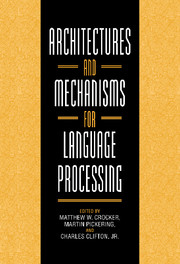1 - Architectures and Mechanisms in Sentence Comprehension
Published online by Cambridge University Press: 03 October 2009
Summary
The architectures and mechanisms underlying language processing form one important part of the general architectures and mechanisms underlying cognition. In this book, the contributors largely focus on the question of what architectures and mechanisms underlie sentence comprehension, but it is our belief that their contributions illuminate the general nature of human language processing in the context of cognition as a whole. Because of the scope of these contributions, this introduction primarily concentrates on sentence comprehension. However, our perspective is to try to use evidence from sentence comprehension to understand the overall nature of language processing.
Let us first try to explain what we mean by architectures and mechanisms, and why these are important. We assume that the human language processor is a particular kind of computational device, and as such needs an organisation that we call its architecture. For instance, the processor might have two components, one dealing with word recognition, and one dealing with putting different words together into sentences. These processes might be completely distinct, in that the second processor could employ the output of the first processor, but have no impact on its internal workings. If so, we would know something about the architecture of the language processor. Architecture, therefore, refers to the static arrangement of components.
In contrast, the mechanisms are the dynamic workings of the language processor.
Information
- Type
- Chapter
- Information
- Architectures and Mechanisms for Language Processing , pp. 1 - 28Publisher: Cambridge University PressPrint publication year: 1999
Accessibility standard: Unknown
Why this information is here
This section outlines the accessibility features of this content - including support for screen readers, full keyboard navigation and high-contrast display options. This may not be relevant for you.Accessibility Information
- 2
- Cited by
